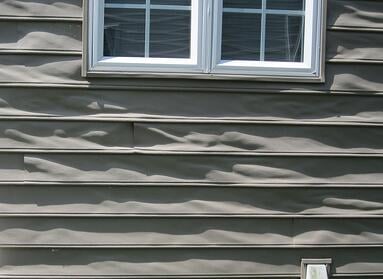 In the 1950's vinyl siding was introduced to the market as a replacement for aluminum siding. Vinyl was and still is sold as a less-expensive alternative to other types of siding, that never needs to be re-painted because of rot or peeling paint.
In the 1950's vinyl siding was introduced to the market as a replacement for aluminum siding. Vinyl was and still is sold as a less-expensive alternative to other types of siding, that never needs to be re-painted because of rot or peeling paint.
When something sounds too good to be true it probably is, and many people soon found out the drawbacks to this material. While vinyl has come a long way in recent years, one of the major problems that's inherent with this product is the fact that sun tends to fade the color over time. So when people need to freshen-up their color, or just want to change to a new one, they ran into problems with paint not adhering to the vinyl and, even worse, found that the siding began to warp after it had been coated.
Despite many people's experience to the contrary, the fact is that vinyl siding can indeed be painted if done correctly. In this week's article we're going to discuss how painting vinyl siding can be done successfully, as well as how to avoid these pitfalls.
Proper Surface Prep
As with any other substrate, vinyl siding needs to be prep'd prior to painting. But the good thing about vinyl is that the amount of surface prep required is often less than that of other types of siding.
Usually a good pre-paint cleaning with some Liquid TSP Substitute will do the job of removing dirt and grime just fine. The only decision you have to make is whether to do your pre-paint cleaning by hand-scrubbing or pressure washing.
If you have mold, mildew, or algae problems you can mix your concentrated Liquid TSP Substitute with a gallon of warm water and one quart of household chlorine bleach. Apply any cleaning solutions that contain bleach to the surface with a pressurized garden-type sprayer rather than using the chemical injector on your pressure washer so you can better control the spray and keep it from getting on unintended surfaces. And be sure to always wear eye protection.
Choosing The Wrong Color Can Warp Your Siding
As many people have found out the hard way, applying a paint color that's darker than the original color of the siding can absorb and trap heat from the sun between the coating and the vinyl causing it to warp beyond repair. This limitation has had many folks regretting their decision to choose vinyl over other materials.
Fortunately, technology has recently come to the rescue to expand the color palette that can be safely applied. With the introduction of Sherwin-Williams' VinylSafe™ Color Pallette that ensures darker colors won't absorb heat, homeowners can now choose from over 100 colors to use on their vinyl.
VinylSafe colors can be tinted in several of SW's popular exterior paints, such as SuperPaint, Duration, Resilience, and Emerald.
Making Sure It Sticks
As for the concern of paint sticking to vinyl, many of today's high-quality 100% acrylic coatings will adhere well to the siding. But there's only one way to tell for sure, and that's to apply a test patch to the siding and perform an adhesion test.
To perform an adhesion test:
- Apply the new paint to a few small areas (12” x 12” or so) on different sides of the home, then allow it to dry for a few days.
- Take a break-away razor knife or a utility knife with a sharp blade and score the surface of the newly-applied paint in a checkerboard pattern (like you’re playing tic-tac-toe), and also with some X’s so that the lines intersect at sharp angles. Make sure you use firm enough pressure that your scored lines penetrate the new coating.
- Take some good quality clear packing tape and apply the tape over top of the scored areas. Use your hand to apply firm pressure to the tape to make sure it is well-adhered to the surface. Grab a corner of the tape and peel it off of the surface at a sharp angle.
- If you have only a very small amount of paint film on the tape then you should have good enough adhesion to paint, but if anything more than a very small amount of paint film comes off onto the tape then you do not.
If the adhesion test fails then you will either need to apply a full prime coat prior to painting, or choose a higher-quality paint.
Follow these steps and you can pull-off a successful re-paint of your vinyl siding and have a good selection of colors to choose from in the process.
If you're in the Greater Pittsburgh or Western Pennsylvania areas and would like some assistance with your vinyl siding painting project please give us a call at 724-898-2446, visit our 'Contact Us' page, or click on the button below to have us contact you.

photo by: ArmchairBuilder.com / CC BY 3.0






 In the 1950's vinyl siding was introduced to the market as a replacement for aluminum siding. Vinyl was and still is sold as a less-expensive alternative to other types of siding, that never needs to be re-painted because of rot or peeling paint.
In the 1950's vinyl siding was introduced to the market as a replacement for aluminum siding. Vinyl was and still is sold as a less-expensive alternative to other types of siding, that never needs to be re-painted because of rot or peeling paint.
